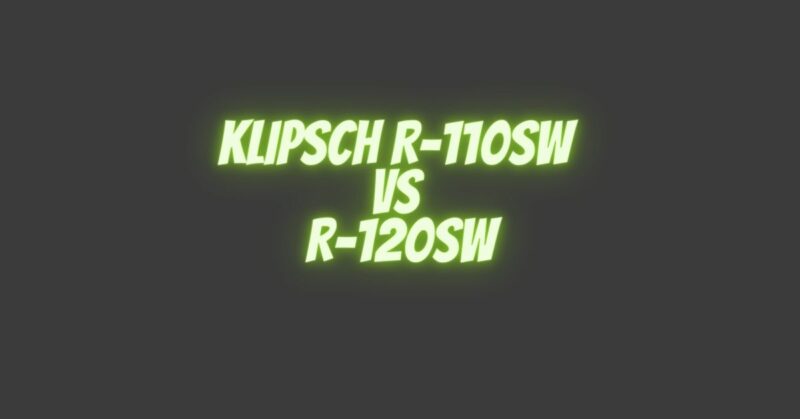When it comes to elevating your home audio or home theater experience with deep, rich bass, Klipsch is a name that frequently stands out. In the world of Klipsch subwoofers, the R-110SW and R-120SW are two formidable contenders. In this article, we’ll compare the Klipsch R-110SW and R-120SW subwoofers, highlighting their similarities and differences to help you decide which one is the right fit for your audio needs.
Klipsch R-110SW
- Amplifier Power: The Klipsch R-110SW boasts a robust built-in amplifier with 450 watts of dynamic power and 150 watts of continuous power. This powerful amplifier ensures that the subwoofer can deliver impactful bass even in larger rooms.
- Driver Size: At the core of the R-110SW is a 10-inch copper-spun front-firing woofer. This driver is designed to provide a clean and precise low-frequency response, ensuring that the bass is both powerful and accurate.
- Frequency Response: The R-110SW offers a frequency response range of 27Hz to 125Hz. While it may not reach the absolute lowest frequencies, it still covers a wide range, making it suitable for both music and movies.
- Crossover Frequency: The subwoofer features an adjustable low-pass crossover that allows you to fine-tune the integration of the subwoofer with your main speakers. This customization ensures a seamless blend between the subwoofer and your audio system.
- Connectivity: It provides both line-level inputs and outputs, as well as LFE (Low-Frequency Effects) inputs, ensuring compatibility with various audio systems and receivers.
Klipsch R-120SW
- Amplifier Power: The Klipsch R-120SW is equipped with a powerful built-in amplifier, delivering 400 watts of dynamic power and 200 watts of continuous power. This substantial power output allows it to handle demanding bass passages with ease.
- Driver Size: Similar to the R-110SW, the R-120SW features a 12-inch copper-spun front-firing woofer. This larger driver provides even more impactful and accurate bass response.
- Frequency Response: The R-120SW offers a frequency response range of 29Hz to 120Hz. While not reaching as low as the R-110SW, it still covers a wide spectrum of bass frequencies, providing a solid foundation for your audio and home theater experience.
- Crossover Frequency: Like the R-110SW, the R-120SW also features an adjustable low-pass crossover, allowing you to tailor the subwoofer’s performance to match your specific speaker setup.
- Connectivity: It offers the same range of connectivity options as the R-110SW, including line-level inputs, outputs, and LFE inputs, ensuring seamless integration into your audio system.
Key Differences
The primary differences between the Klipsch R-110SW and R-120SW lie in their power output, driver size, and frequency response.
The R-110SW, with its 10-inch driver, is a powerful and compact subwoofer that excels in delivering accurate and punchy bass. It may not reach the deepest frequencies, but it is well-suited for smaller to medium-sized rooms.
On the other hand, the R-120SW, with its 12-inch driver, offers a larger driver and a slightly wider frequency response range. This makes it capable of delivering deeper bass and greater impact, making it an excellent choice for larger rooms or those who crave powerful low-end performance.
Conclusion
Both the Klipsch R-110SW and R-120SW are exceptional subwoofers that can significantly enhance your audio and home theater experience. Your choice between the two will depend on your room size, budget, and specific bass preferences.
If you have a smaller to medium-sized room and prioritize precise, punchy bass, the R-110SW is a great choice. On the other hand, if you have a larger room or simply want more impactful and deeper bass, the R-120SW is the way to go. In either case, Klipsch’s commitment to quality and performance ensures that you’ll enjoy a remarkable low-frequency audio experience that complements your music and movie enjoyment.


